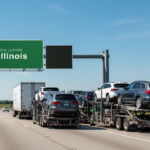What Factors Affect Car Shipping Rates?

Curious to know what actually determines the cost of shipping a vehicle? Are you moving, purchasing a vehicle out of state, or shipping one to a family member? US Car-Go Freight offers auto transport easy and convenient. But before arranging your shipment, it’s valuable to know what contributes to the cost.
The reality is that a number of dynamic variables control car shipping prices — and while brokers facilitate pairing customers with carriers, it is the carriers that ultimately determine the market rate. Let’s dismantle the key components that drive the cost of getting your vehicle shipped.
1. Time of Year
Car shipping prices go up and down with seasonal demand. In spring and summer, when most families relocate and snowbirds fly back home, demand is high — so are prices. Conversely, autumn and winter usually provide more bargains. But holiday seasons and stormy weather can still push prices higher because of increased risk and reduced driver availability.
Pro tip: If you’re open to scheduling around off-peak months, you might save money by booking your shipment then.
Weather plays a large role in transport logistics. Rain, snow, and ice produce hazards that could delay transit or compel carriers to use longer, safer routes. Under extreme conditions, carriers may even alter equipment with snow chains or bypass entire areas altogether — all of which can add to the cost.
Location is important — both the distance and accessibility of the pickup and drop-off points. Routes through major cities and along interstates typically cost less because they’re common and easy for carriers to reach. Conversely, rural or remote locations usually translate into additional mileage and effort for the carrier, which translates to an increased quote.
Did you know? US Car-Go Freight strives to negotiate reasonable pricing no matter what your zip code is.
4. Type of Transport: Open vs. Enclosed
Your shipping method choice has a major impact on the price. Open transport is standard in the business — it’s cheap, fast, and abundant. But for shipping a classic, exotic, or luxury automobile, enclosed shipping provides complete weather and road detritus protection — at an extra cost.
Optional add-on: Door-to-door delivery also adds to costs over terminal-to-terminal drop-off.
5. Truck Load Efficiency
Transport carriers aim to fill each load to maximize profits. If your car is the only vehicle going in a certain direction, the carrier may charge more to make the trip worthwhile. That’s why scheduling flexibility can help lower your cost — it gives us time to match your vehicle with an efficiently routed load.
6. Vehicle Size & Weight
The larger or more massive your car, the more expensive it will be to transport. SUVs, trucks, vans, and large vehicles occupy more space and put more weight on the trailer. Small vehicles such as sedans, hatchbacks, and compact hybrids are cheaper to transport.
7. Vehicle Condition
Is your vehicle drivable? If your vehicle can roll, brake, and steer, a carrier can load it onto a trailer more easily. Non-drivable vehicles take additional equipment such as winches or forklifts, which means more labor and time — and thus, a surcharge.
Important: Tell the truth about your vehicle’s condition early to prevent last-minute charges.
8. Shipping Timeline
Need your vehicle picked up day after tomorrow? Expedited delivery is an option, but you’ll pay more. If your pickup and delivery windows are flexible, you will probably pay less. Carriers like advance scheduling to plan their routes and make trailer fills optimally.
9. Fuel Prices & Market Conditions
As with any shipping business, car transport is subject to fuel prices. Higher diesel fuel prices add to carriers’ overhead, and that expense passes on to consumers. Economic situations, driver availability, and nationwide occurrences (such as the COVID-19 pandemic) can also lead to short-term price spikes.
10. Personal Items in the Vehicle
It’s tempting to pack your car with personal items to save money on moving expenses — but carriers generally try not to haul household items because of insurance and weight restrictions. Cars packed too tightly add weight to the vehicle, which impacts transport cost and regulation.
Reminder: Empty your car before shipping unless your carrier gives approval otherwise.
11. Top-Load Request
If you’re shipping on open transport, you are sometimes able to request a top-load position — the top deck of a car hauler. This protects your vehicle better from fluid leaks and flying road debris. Though not necessary, this service can run an extra $100 or so.7. Vehicle Condition
Final Thoughts
Car transport doesn’t have to be difficult — especially when you know what impacts the cost. At US Car-Go Freight, we aim to make auto shipping hassle-free, clear, and affordable. Whether shipping in-state or out-of-state, we’ll guide you through each detail.
FAQs – US Car-Go Freight
There are several variables — including season, distance, vehicle size and condition, and pickup location — that could affect the final rate. We’ll always be up front in telling you what you’re paying for.
Peak demand in spring and summer can drive up prices, but fall and winter months typically provide lower rates because of reduced shipments.
Enclosed shipment provides further security for your exotic or vintage vehicle from weather and road debris. Although it’s a more expensive service, many clients believe it’s worth the money.
Yes. When your car is not running, there is some special equipment involved in loading and unloading it, which adds to the cost.
Top-load is loading your car on top of an open trailer’s higher level. It prevents fluid drips from other cars and provides cleaner transportation — although it does cost a bit more.
Book in advance, have flexible pickup dates, and transport in off-season months. You can also ask about discounts if you’re military, a student, or shipping more than one vehicle.
Yes. Increased diesel prices directly affect transport prices. We always strive to keep your quote fair, even when the market changes.
Your first quote is an accurate approximation. End pricing is subject to carrier availability and real-time market conditions, but we work diligently to keep it within your budget.
Need an Instant Quote?
Use our FREE Car Shipping Calculator to get a personalized, no-obligation quote in seconds. Just enter a few quick details, and we’ll handle the rest.
Recent Posts.
- Top States Americans Are Moving To and FromTop States Americans Are Moving To and From Top States… Read more: Top States Americans Are Moving To and From
- Moving Out of Illinois – Relocation GuideMoving Out of Illinois – Relocation Guide Moving Out of… Read more: Moving Out of Illinois – Relocation Guide
- Navigating the Road of Vehicle ShippingNavigating the Road of Vehicle Shipping Navigating the Road of… Read more: Navigating the Road of Vehicle Shipping



